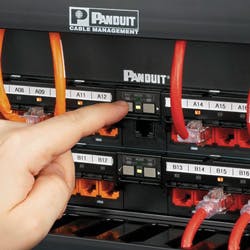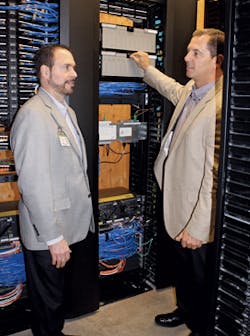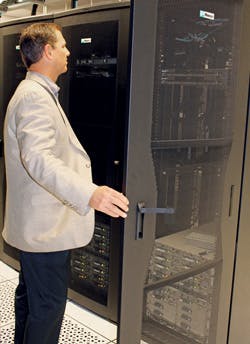Better location and technology deliver better care at new Illinois hospital
From the September, 2013 Issue of Cabling Installation & Maintenance Magazine
The 289-bed Silver Cross Hospital in New Lenox, IL uses a Category 6 cabling system to support the demanding multimedia applications of a healthcare environment.
By Maureen Selfridge, RCDD, NTS; General Cable
After more than a century of expanding and improving its healthcare facility in Joliet, IL, Silver Cross Hospital’s board of directors made a bold decision to construct an entirely new replacement hospital on a 76-acre parcel just a few miles away in New Lenox. In 2007, the Illinois Health Facilities Planning Board granted Silver Cross approval to proceed with plans to construct the 289-bed facility, and in 2008 Silver Cross broke ground. This new medical facility that opened its doors in 2012 is indeed groundbreaking.
Designed to enhance patient care and incorporate family members into the healing process, the new Silver Cross hospital features larger, private family-friendly rooms, a more-efficient environment to improve access to services, and advanced technology to improve care delivery, including an integrated procedural care unit with state-of-the-art surgical systems and diagnostic imaging. From telemetry, monitoring and nurse call systems, to digital video, security and building automation systems, Silver Cross encompasses a myriad of advanced healthcare and building technology applications--all of which are supported by Panduit (www.panduit.com) and General Cable’s (www.generalcable.com) advanced PanGen 6 Premium network cabling system.
New design, fresh start
While most hospitals and healthcare facilities today undergo renovation of existing facilities, constructing an entire new facility gave Silver Cross the rare opportunity to design from the bottom up.
"We had expanded as much as we could with the previous Joliet facility, piecemealing with various wings added here and there since the late 1800s," says Bill Bisch, director of technical services for the hospital. "What we ended up with was an inefficient way to care for patients. For example, the emergency department and radiology were in completely different wings, which wasted a lot of time for both staff and patients."
At the new hospital, the emergency department and radiology are located adjacent to each other so it takes just minutes for patients to get where they need to be. In fact, for the new hospital, Silver Cross took an integrated approach where surgery, endoscopy, interventional cardiology and radiology procedures come together in a single area to minimize unnecessary patient movement, maximize efficiency and improve patient care and safety.
According to Bisch, the network infrastructure at the old facility was equally inefficient. "Much of the old hospital was built before LANs were even thought of, and only our most modern sections had decent-sized telecommunications spaces," he says. "We had several makeshift, tiny technology rooms and the network infrastructure itself was out of date. We were able to put enough money into the network to keep it stable, but we didn’t do any major upgrades since we knew we were building a new hospital, which would give us the opportunity to start fresh."
When it came time to design the network infrastructure for the new Silver Cross Hospital campus, which includes the main hospital, a medical services building and a medical office building, Bisch and the technical services staff needed to remain fiscally conservative while planning for the future as much as possible. "We didn’t want anything outdated, but we also didn’t want to spend additional money on anything we didn’t foresee needing," says Bisch. "Money is always an issue and we had to pick and choose. Where it made the most sense is where we deployed the most future-proof technologies."
For the horizontal cabling from telecommunications spaces to the more than 9,500 outlets throughout the hospital, Silver Cross decided to deploy Category 6 twisted-pair cabling rather than the very latest Category 6A.
"When we looked at the horizontal cabling, it made more sense to go with Category 6," says Dan Siebert, technical support specialist at Silver Cross. "We realized that Category 6A was going to be a lot more expensive. Furthermore, in looking at how technology is progressing, we see a shift toward wireless and less emphasis on outlying connections to the network due to operating systems no longer residing on end devices. In fact, the majority of our outlets would be adequately served with Category 5e. We saw the benefit of adding the most future-proof technologies at the backbone and data center level of the infrastructure."
To connect 21 telecommunications rooms (TRs) throughout the new complex to the new data center located in the medical services building, Silver Cross deployed dual redundant 24-strand multimode fiber pathways from each TR to Level 2 Cisco Nexus 7000 series switches that serve as the distribution points for each building. Each building is then connected via dual redundant singlemode fiber pathways to Level 2 and Level 3 switches in the data center that enable 10- and 20-gigabit routing, respectively, between buildings.
"We designed the backbone in a way that maintains complete redundancy and allows each building, or pod, to function as its own data center," says Siebert. "We also centrally located the distribution points in each building to ensure that we can easily maintain 10-Gigabit speeds over the multimode fiber today and support higher speeds in the future without distance becoming an issue. With the amount of fiber we deployed, and the use of singlemode to the data center, we don’t anticipate that we will ever outgrow the infrastructure."
Within the data center itself, Silver Cross deployed an end-of-row configuration in which distribution switches redundantly connect via plug-and-play fiber to access-layer switches in each row that connect to the servers in the row via copper cabling. This allows Silver Cross to maintain separate rows of cabinets for the storage area network and servers, as well as two segregated rows for vendor access.
"We have several outside vendors that need to come in and maintain and service their specific healthcare or other facilities equipment," says Siebert. "We provide the infrastructure and the access, but they can only enter the vendor side of the data center--they have no access to our core area."
Keeping it local
When it came time for Silver Cross to choose the components and the installation contractor for their new network infrastructure, performance and location were the biggest factors.
For the horizontal infrastructure, the hospital selected a PanGen (www.pangensolutions.com) Category 6 solution, featuring cable and connectivity from Panduit and General Cable. "We had used some Panduit and General Cable products at the old facility, but it was nothing compared to the scale of the new hospital," says Siebert. "We did some testing but didn’t go completely overboard--when it comes to the components, there are a few market leaders that stand above the rest, and with Panduit and General Cable, we weren’t worried about any performance issues. They were also very flexible and willing to work with us, and we had the added benefit of the Panduit headquarters being just down the road, which fits our mandate of using local providers."
Designed to meet or exceed ANSI/TIA-568-C.2 Category 6 channel requirements, the horizontal solution installed at Silver Cross consisted of more than one million feet of General Cable GenSpeed Category 6 cable and Panduit Category 6 Mini-Com TX6 jacks, faceplates, patch cords and flat and angled patch panels. To deliver cable television service to patient rooms, Silver Cross also deployed more than 80,000 feet of Carol Brand RG 6/U coaxial cable from General Cable.
The backbone and data center infrastructures for Silver Cross consist of a combination of multimode and singlemode fiber-optic and copper cables from General Cable, as well as patch panels, connectivity, cabinets and power distribution units from Panduit. For fiber-optic connections in the data center, Silver Cross selected Panduit’s QuickNet preterminated fiber system. The system consists of 100-percent factory-tested 12-fiber optical trunk cable assemblies preterminated with MTP brand connectors that connect optical cassettes with 6 duplex LC fiber connectors on the front for patching to equipment. The optical cassettes are housed in adapter panels that hold up to four cassettes in a single rack unit space. All equipment and connections were housed in Panduit’s Net-Access switch and server cabinets that maximize space, provide thermal management with improved airflow and offer superior cable management with flexible cable routing and bend-radius control.
The contractors bidding to install the infrastructure also had to be local companies. "We wanted to create jobs and help the local community as much as possible," says Bisch. "We opened up the bidding to several different local contractors and we were quite pleased with every low-voltage installation."
To install the network infrastructure for the new hospital, Silver Cross ultimately selected Low Voltage Solutions (www.lvsolutions.com), an installer located just 12 miles southeast of the new hospital with 15 years’ experience in deploying low-voltage systems for a variety of customers, including other hospitals.
"While we had done some outpatient facilities and reconfigurations for Silver Cross in the past, we were thrilled that they were giving work to local contractors for the new hospital," says Gary St. Cin, president and owner of Low Voltage Solutions. "This was a great project for us and we had a steady crew of 14 on the job for well over a year."
For procurement, distribution and staging of the infrastructure components, Silver Cross also used a local Illinois source: Graybar. With offices in Glendale Heights and a large zone warehouse in Joliet, Graybar collaborated with both Panduit and General Cable to ensure that product was delivered on schedule. "Through our close working relationship with Low Voltage Solutions, we provided logistical support for the new hospital and were pleased to be involved in something right in our back yard," says Joseph Corbett, branch manager for comm/data at Graybar. "Due to the complexity of the project, we needed to have product ready to go at a moment's notice. In response, we were able to provide staging of material at our Joliet warehouse, which is located just a few miles from the new hospital."
New systems, better care
With an advanced, redundant network infrastructure in place, the new Silver Cross Hospital is able to support a variety of updated healthcare and building applications beyond just data and Voice over IP (VoIP). Multimedia applications running over the new infrastructure include video conferencing, digital signage and smartboards. Security and life-safety applications include everything from video surveillance and access control, to infant protection/wander prevention, emergency radio and nurse locator systems. Silver Cross has even deployed a da Vinci brand surgical robot system that facilitates complex surgery using a minimally invasive approach.
"We have so much more technology than we did before, and the ability to connect many more services to the network, which allows us to provide better patient care," says Bisch. "Our telemetry system is much more solid and covers a wider area, and we have new patient conveniences like self-registration and check-in and free wireless Internet. We have many more IP addresses that use the PanGen system to ‘talk,’ including temperature sensors that automatically monitor freezers and refrigerators that house medicine, blood and even food. We can print out daily reports and make sure that all temperatures are within the right range."
According to Siebert, in addition to the technology that the new hospital can provide, the new cabling infrastructure also makes for a much more solid, stable network. "Our old network was like one big VLAN and one issue affected everything," he says. "The network is now much more stable and we can easily set up separate VLANs as needed. From a security standpoint, it’s much easier to lock things down. Because of the network stability, we’re seeing a lot more usage. We are constantly being asked to add new technology and new equipment, something that we wouldn’t have been able to respond to in the previous facility."
In addition to wireless Internet access via WiFi access points, Silver Cross also deployed a comprehensive distributed antenna system (DAS) to improve cellular service throughout the hospital. "We can support all of the leading carriers like AT&T, Verizon and Sprint. People are really happy that we have a DAS--we use it for telemetry and for patients and their families to stay connected to the outside world," says Siebert.
One of the Panduit solutions that Silver Cross deployed and hopes to thoroughly take advantage of is the PanView iQ data center infrastructure manage-ment (DCIM) system that uses intelligent patch panels and connectivity to provide real-time monitoring and visibility of the infrastructure. The system features angled patch panels outfitted with intelligence modules that monitor each port and PViQ patch cords that provide visual indication of connections with an integrated light-emitting diode (LED). Using Panduit’s Physical Infrastructure Manager software, the system can document and monitor changes and unused ports, and monitor power consumption, temperature and humidity through a variety of available sensors.
"While we haven’t yet made full use of the infrastructure management solution, we hope that once fully programmed, we will be able to have a complete view of the infrastructure and program the system to guide us through reconfigurations," says Siebert. "Thus far, our favorite feature is the ability to press a button on the patch panel and see the cable for that specific port light up on the other end. This is very helpful, especially when cables get moved and the labeling is incorrect."
Getting it done
While Silver Cross Hospital is now able to better support the technology requirements of today’s healthcare applications and improve patient care, the infrastructure deployment wasn’t without challenge--even for a brand new facility.
"One of the nice things about building new versus renovating an existing facility was that we did not have to deal with infection-control issues," says St. Cin. "However, the new construction presented other challenges. For example, we needed to pull backbone cable to the data center, but the pathways and data center were not ready. We therefore had to complete the cabling on all the floors in the hospital and just coil up the infrastructure and wait for the rest of the construction to be complete."
Once the pathways and data center were complete, Low Voltage Solutions had just three weeks to complete the installation, test the infrastructure and go live. "Just because the data center wasn’t live, that didn’t stop everything else from needing to work," says Siebert. "We needed working phones, elevators, e911 systems, fire alarms, lighting and HVAC system, and we needed to provide connectivity for that to happen. We essentially had to connect these systems back to equipment in our old Joliet location to get them functioning, and once the new data center was completed, we moved everything over."
According to Siebert, another challenge was responding to last-minute technology needs for each department. "Not all decisions were made before the network was up and running, and some systems had to be quickly tweaked to meet the needs for each department and make sure all patient devices were active in time for the occupancy date," he says. "I think our biggest challenge moving forward will be growing our staff and having the work processes in place to respond to all the technology demands that the new infrastructure enables."
In what was likely the biggest undertaking in Silver Cross’s history, the staff and patients all were moved to the new hospital in a single day, and just two days later the new hospital welcomed its first baby. The ambulances ran continuously, transporting 120 patients, one at a time, three miles from the existing Joliet location to the new campus with police from three neighboring towns ensuring easy passage. The previous Joliet facility is scheduled to become a veterans’ clinic.
Despite the challenges and enormous undertaking of such a large project, Siebert was pleased that the infrastructure deployment was successfully accomplished in a short amount of time. "We finished everything on schedule, and we are now able to give the community better care," he says. ::
Maureen Selfridge, RCDD, NTS is regional sales manager for communication products with General Cable (www.generalcable.com).
Archived CIM Issues









